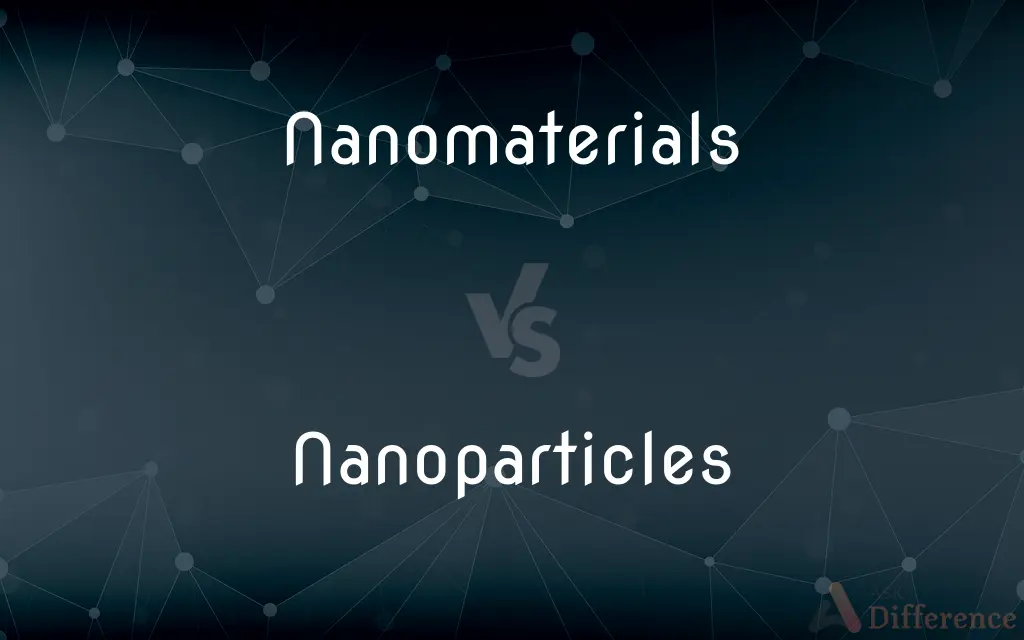Nanomaterials vs. Nanoparticles — What's the Difference?
By Fiza Rafique & Urooj Arif — Published on April 24, 2024
Nanomaterials are materials with any external dimension in the nanoscale or having internal structure or surface structure in the nanoscale, while nanoparticles are particles between 1 and 100 nanometers in size.

Difference Between Nanomaterials and Nanoparticles
Table of Contents
ADVERTISEMENT
Key Differences
Nanomaterials encompass a broad category of materials that include nanoparticles but also extend to nanostructured materials like nanotubes, nanofibers, and nanocomposites. These materials can have unique physical, chemical, and biological properties different from their bulk counterparts due to their small size and high surface area to volume ratio. Nanoparticles, on the other hand, specifically refer to ultrafine particles with dimensions between 1 and 100 nanometers. Due to their size, nanoparticles exhibit unique properties that are not found in the same materials at a larger scale, such as increased reactivity and altered electrical or optical behaviors.
Nanomaterials are utilized across various fields, from medicine and electronics to energy storage and environmental applications, leveraging their enhanced reactivity, strength, electrical characteristics, and other novel properties. While nanoparticles can be made of metals, ceramics, polymers, or carbon-based materials and are used in applications like drug delivery systems in medicine, catalysts in chemical reactions, and pigments in paints and coatings.
The distinction between nanomaterials and nanoparticles lies in their scope and application. While nanoparticles are a subset of nanomaterials, characterized by their specific size range, nanomaterials include a wider variety of nano-sized structures and composites, each with its unique set of properties and uses.
Nanoparticles are primarily defined by their size, which imparts them with a high surface area to volume ratio, leading to unique optical, magnetic, and electrical properties. Nanomaterials, including those that are not nanoparticles, such as nanofibers or nanosheets, exploit the benefits of the nanoscale in different ways.
The key difference between nanomaterials and nanoparticles lies in their definition and range of applications. Nanomaterials refer to a broad category that encompasses various nano-sized structures and composites, including nanoparticles, which are specifically sized particles that exhibit unique properties due to their small dimensions. Both play crucial roles in advancing technology and offering solutions across a wide range of industries.
ADVERTISEMENT
Comparison Chart
Definition
Materials with any external or internal dimension in the nanoscale.
Particles with dimensions between 1 and 100 nanometers.
Scope
Broad, includes nanoparticles and other nanostructured materials.
Specific, refers to particles within a defined size range.
Properties
Varied, depending on structure and composition.
Unique optical, magnetic, and electrical properties due to size.
Applications
Medicine, electronics, energy storage, environmental solutions.
Drug delivery, catalysts, pigments, coatings.
Examples
Nanotubes, nanofibers, nanocomposites.
Metal nanoparticles, ceramic nanoparticles, polymer nanoparticles.
Compare with Definitions
Nanomaterials
Include structures like nanofibers and nanocomposites.
Nanofiber filters for air purification systems.
Nanoparticles
Used in targeted drug delivery due to their small size.
Lipid nanoparticles for RNA delivery in vaccines.
Nanomaterials
Have enhanced properties due to their nano-scale dimensions.
Nanocomposites in batteries for improved energy storage.
Nanoparticles
Exhibit properties not seen in bulk material due to size.
Gold nanoparticles used in rapid diagnostic tests.
Nanomaterials
Comprise both particles and other nano-structured forms.
Nanostructured catalysts for faster chemical reactions.
Nanoparticles
Ultrafine particles sized between 1 and 100 nanometers.
Silver nanoparticles used for their antimicrobial properties.
Nanomaterials
A broad category of materials with nano-scale features.
Carbon nanotubes used in making stronger and lighter materials.
Nanoparticles
Serve as catalysts with increased reactivity.
Titanium dioxide nanoparticles in photocatalytic water splitting.
Nanomaterials
Utilized across various applications for their unique characteristics.
Nano-coatings for anti-reflective surfaces.
Nanoparticles
Formulated from metals, ceramics, polymers, or carbon.
Polymer nanoparticles for controlled drug release.
Nanomaterials
Plural of nanomaterial
Nanoparticles
Plural of nanoparticle
Common Curiosities
What are some applications of nanomaterials?
Nanomaterials are used in various fields, including medicine for drug delivery, electronics for improved components, energy storage in batteries, and environmental applications like filtration.
Can all nanomaterials be considered nanoparticles?
Not all nanomaterials are nanoparticles; nanomaterials can also include structures like nanotubes and nanofibers, which do not fall into the specific size range of nanoparticles.
How are nanoparticles used in medicine?
In medicine, nanoparticles are used for targeted drug delivery, allowing drugs to be delivered directly to diseased cells, reducing side effects and improving efficacy.
What makes nanomaterials important in technology and science?
Their unique properties and behaviors at the nanoscale enable advancements in technology and science, offering solutions to complex problems in health, energy, and the environment.
What is the future of nanomaterials and nanoparticles?
The future of nanomaterials and nanoparticles lies in further exploring their potential applications, improving their safety and sustainability, and integrating them into new and existing technologies for better performance and efficiency.
How are nanoparticles made?
Nanoparticles can be made through various methods, including chemical synthesis, grinding, or as byproducts of combustion processes.
Why do nanoparticles have unique properties?
Their unique properties arise from their small size, which gives them a high surface area to volume ratio, affecting their optical, magnetic, and electrical behaviors.
What defines a nanomaterial?
A nanomaterial is defined by having external or internal features in the nanoscale, typically offering enhanced or unique properties.
How small are nanoparticles?
Nanoparticles are particles with dimensions ranging from 1 to 100 nanometers.
Are there environmental concerns associated with nanoparticles?
Yes, there are concerns about the potential environmental impact of nanoparticles, including toxicity to aquatic life and challenges in recycling or disposal.
Share Your Discovery

Previous Comparison
Dual Federalism vs. Co-operative Federalism
Next Comparison
Ethnicity vs. Social ClassAuthor Spotlight
Written by
Fiza RafiqueFiza Rafique is a skilled content writer at AskDifference.com, where she meticulously refines and enhances written pieces. Drawing from her vast editorial expertise, Fiza ensures clarity, accuracy, and precision in every article. Passionate about language, she continually seeks to elevate the quality of content for readers worldwide.
Co-written by
Urooj ArifUrooj is a skilled content writer at Ask Difference, known for her exceptional ability to simplify complex topics into engaging and informative content. With a passion for research and a flair for clear, concise writing, she consistently delivers articles that resonate with our diverse audience.













































